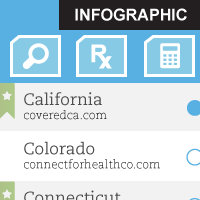
How to Improve Marketplaces to Provide Consumers with Crucial Health Insurance Information
02.13.2014
As we move into the last two months of the open enrollment period, government officials and advocates are thinking about how to better reach consumers and help them select a plan to enroll in. One way to improve the consumer experience in marketplace websites is to show consumers more information up front—information that allows them to compare and contrast plan details and financial assistance benefits—before they invest time creating personal accounts and completing an application.
What we found out about how well consumers can window-shop on marketplace websites
Families USA evaluated the window-shopping experiences of consumers in state-based marketplaces and on healthcare.gov in January. We found that in too many marketplaces, consumers don’t see important information while they are window shopping. This information can range from a list of which providers are in a network, to whether certain medicines are on the plan drug formulary. For lower-income consumers who have little disposable income to pay for doctor visits, this could mean the difference between buying a health plan or remaining uninsured.
- Some websites fail to clearly show low-income consumers special silver-level plans that feature reduced out of pocket costs. These plans can lower or eliminate deductibles for consumers who qualify.
- Some marketplaces have Spanish websites and materials in other languages. Others don’t.
- Some sites have user-friendly calculators that estimate what consumers will pay in monthly premiums after they get financial help. On other websites, however, those features don’t appear until after you have created an account.
Choosing a health plan is an important decision. Without the necessary information, consumers can face major problems down the road. They may lose access to their trusted doctor because they didn’t understand which plan the doctor was in. Or they may face higher out-of-pocket costs because they chose a plan that they didn’t quite understand.
Marketplaces should use all of the tools available to them—outreach messages, navigators and assisters, and their own websites—to educate consumers about how to choose a plan that is right for them.
How to improve the window shopping experience in health insurance marketplace websites
Some improvements to the marketplace window-shopping experience should be done as soon as possible. For instance, marketplaces should immediately correct information about plan deductibles, and they should immediately provide links to plan provider directories and drug formularies. Other improvements, such as creating a search tool that allows consumers to quickly find all of the plans that include their provider or cover their drug, or creating a Spanish version of the website, will take time and partnership with contractors, like IT vendors and translators. That‘s why it’s important for us to get an early start on assessing how marketplace websites can continue to become more user-friendly and provide the right information when the consumer needs it most. The best marketplace websites (such as Connecticut’s summary of a consumer’s costs in each plan, consumer-friendly link to “check if your doctor is in-network”, and links to plan quality ratings and detailed plan documents) offer terrific examples of what’s most effective for the consumer. It’s our hope that sharing these best practices will help all states adopt them, improving the consumer experience for the coming year.
How you can weigh in on improving the consumer experience for health insurance marketplace websites?
Last week, the Department of Health and Human Services (HHS) released proposed guidance that would require health plans selling in the federal marketplace to provide a direct link to provider directories and drug formularies for 2015, instead of routing consumers to a website that is potentially confusing to them. We applaud this guidance. If you live in a state with a federal or partnership marketplace, see our blog HHS Releases New Requirements for Health Plans in Federally Facilitated Marketplaces for 2015 about these, and other proposed plan requirements, that are open for comment until February 25, 2014.
You can also use other avenues to communicate with HHS about the marketplace website. For instance, when you visit healthcare.gov, use the “was this helpful” bubbles on the bottom of some pages to suggest improvements.
If you live in one of the states running its own marketplace, now is the time to talk with state administrators and your marketplace board about any improvements you want to see in your state’s health plans. You can also offer website usability suggestions to improve the consumer experience in the coming year.
Help Families USA monitor improvements. Send us your recommendations.
We are keenly interested in hearing directly from you about what improvements you would recommend for marketplace websites. We will be actively monitoring websites for improvement in 2014 and would welcome your direct input. Please contact lrivera@familiesusa.org to share any recommendations that you make to your state administrators or marketplace board.

